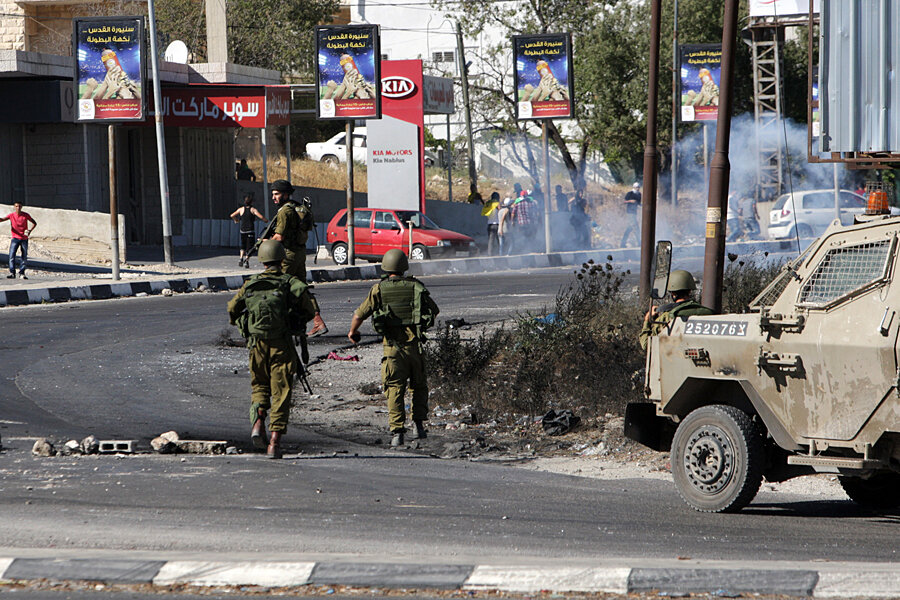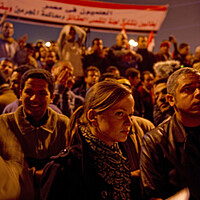Israeli ground invasion of Gaza ramps up stakes of conflict with Hamas
Loading...
| Gaza City, Gaza
As Israeli tanks rolled into Gaza overnight and the darkness was broken by explosions from Israel shelling, the residents of Gaza hunkered down for what both Israel and Hamas claim will be a decisive showdown.
Israel is gambling that that benefits of its ground assault in Gaza will outweigh the the costs, with Hamas and other militant groups' offensive capabilities severely degraded, minimal casualties for Israeli troops, and without the serious public relations backlash of Operation Cast Lead in 2008-2009, which prompted a UN report that accused both Israel and Hamas of war crimes. In particular it says it intends to destroy a Hamas tunnel network it says is giving militants access to Israel.
Hamas is gambling too, that its operatives and military leaders will be able to evade far better-equipped Israeli soldiers, inflict serious damage on the enemy, and end up extracting meaningful concessions from Israel in the economic blockade of Gaza and the release of militant prisoners thanks to its refusal to rein in the rocket-fire that was the proximate cause for the latest escalation.
If past history is anything to go by, however, neither side is going to get what they want. Meanwhile, average people in Gaza are caught in the middle again.
Hamas has less to lose politically for now, with public pressure high for improving Gaza's situation through better cease-fire terms than the last major confrontation with Israel in 2012. And Israel risks losing international support for its campaign against Hamas if, as expected, the civilian death toll mounts.
At least 264 people have been killed in Gaza so far, including 56 children, according to Health Ministry spokesman Ashraf Al Qedra. He said that more than 2,000 people have been wounded. One Israeli civilian has died, and one Israeli soldier was killed during last night's attack.
The ground invasion appears so far to be limited to Gaza's northern edge. Israeli Prime Minister Benjamin Netanyahu announced at midday that Israel would expand its ground offensive to wipe out Hamas tunnels along the Israeli border. Hamas fighters used one such tunnel yesterday morning to send 13 fighters into Israel to launch an attack on an Israeli kibbutz, which Israeli forces thwarted.
Hamas spokesman Musheer Al Masri, speaking at the Shifa Hospital in Gaza City, promised fierce resistance to the Israeli ground invasion. “The occupation has now expanded its aggression and we will expand our self defense,” he said. He claimed that militants had inflicted high losses on Israeli soldiers. “Netanyahu was totally wrong, and we will face them and Gaza will be a big grave for the Israeli soldiers.”
Friday morning, a steady stream of families on horse- or donkey-drawn carts headed south from Beit Lahiya, an area along Gaza's northern border. A wizened man said he could see tanks, bulldozers, and jeeps on the border from his house in Bait Lahiya, and that he fled after a sleepless night of continuous shelling. He heard the tanks when they rolled across the border last night, and says “the tanks hit everything in front of them.”
But he said they had stopped about 130 feet past the border instead of continuing into Gaza.
Another family, sitting in a cart pulled by a donkey, said they returned home that morning to gather a few supplies – potatoes for cooking and pillows to make them more comfortable in the school where they are taking shelter. They described heavy fire coming from the north, and had no idea when they might head back to their home, says mother Farha Moussa ElAttar. “We have no expectations because there is nothing good.”
Media agency, hospital take hits
Israel's military also continued its aerial bombardment of Gaza. Israel Defense Forces (IDF) have hit 111 locations since last night. Spokeswoman Lt. Libby Weiss says that included rocket stockpiles, rocket launchers, tunnels, and what they call "command and control centers."
But some of the targets appear to have little to do with militants. One of them was of the offices of the Wataneya Media Agency, on the 8th floor of a building in central Gaza City. Director Mustafa Shehada said employees had been working in the building since the start of the conflict, and that 30 employees were sleeping in the office at the time of the strike.
He said there was no warning call to evacuate the building and that fortunately no one was killed. One person was wounded in the strike, which blew out the top floor of the building. A newspaper connected to Hamas has its offices on the fourth floor of the building, but Mr. Shehada says his company has no connections to Hamas or any other political or military group.
Another building hit by airstrikes last night was the Al Wefa Hospital, less than 1.5 miles from the northeastern border of the Gaza Strip. A doctor at the hospital who asked not to be named because he was not authorized to speak to the media, said the Israeli military called the hospital around the time of iftar, when Muslims break their Ramadan fast, and told staff they had five minutes to leave.
Some in Gaza said the owner of the hospital was a member of Hamas, but it was still a hospital filled with patients. Al Wefa specialized in treating severely disabled people, and all 14 patients there were either paralyzed or in a coma, and therefore immobile. Most are also unaware of their surroundings. Staff rushed to evacuate the patients, carrying them out any way they could.
Four minutes after the phone call, the shelling started. The doctor says he carried a 16-year-old girl paralyzed from the waist down out of the hospital as explosions hit the building.
Israel: Military targets among civilians
Lt. Weiss says the damage at Al Wefa hospital was due to a strike on a rocket-launching pad 1,000 feet away, and came after an evacuation warning several days ago. She says the military did launch a "knock on the roof" warning missile on the hospital, which may have caused structural damage to the building. However, Israeli strikes in this conflict have rarely caused damage that far from their targets.
"In no way was the hospital itself targeted," Weiss says.
Israel blames civilian deaths on Hamas, saying the organization hides military assets in civilian areas. Earlier this week, the UN Palestinian refugee agency, UNWRA, found 20 rockets in one of its vacant schools in Gaza, something the agency said was unprecedented in its long history. "A lot of Hamas assets are specifically hidden in places within civilian areas, whether in the basements of hospitals or playgrounds of schools or mixed in with commercial buildings," Weiss says.
The hospital is in an area where Israel dropped leaflets days ago, warning people to leave.
But the doctor says the hospital was targeted – that it was first shelled two days ago, prompting staff to move patients to the first floor. Last night, there were two strikes on the building itself, he says, but not the others around it.
The patients were evacuated to a clinic in Gaza City, where they remained Friday morning. The doctor, still clad in his green scrubs and white rubber shoes, recalled their panicked flight after the five-minute warning. He said he had not slept since the bombardment and scoffed at the idea that a warning excused Israel from responsibility for any patient deaths.
“You're there with paralyzed patients. How are you supposed to get them out?” he asked.
Staff writer Christa Case Bryant contributed reporting from Jerusalem.






